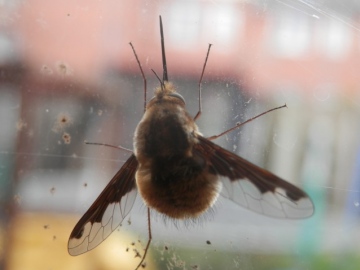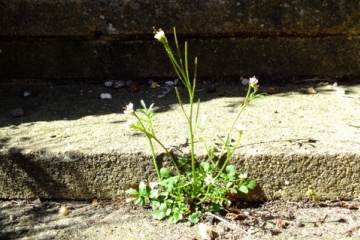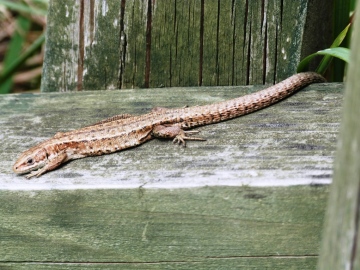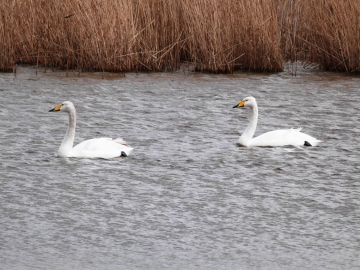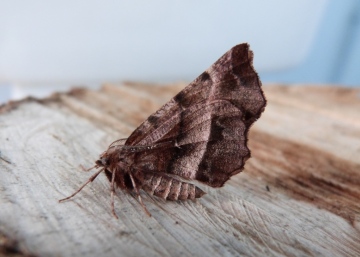Your Forum
The weblog below is for naturalists to use to report interesting sightings, ask questions, report on field meetings and generally post pictures and any information or questions generally relevant in some way to the wildlife and geology of Essex. You will need to register and be logged-on to post to the forum, and you need to upload pictures first, for use in posts. Find out more
|
Tue 30th April 2013 07:17 by Peter Harvey
The Dark-edged Bee Fly is a spring insect (and spring has finally arrived!). Our map for the whole country only shows records submitted on this website, so mostly Essex records. The excellent book British soldierflies and their allies by Alan Stubbs & Martin Drake states that the Dark-edged Bee Fly is found in much of southern England, the Midlands and the Welsh lowlands, also extending into southern Scotland and further north along the west coast. It is a nice insect! (unless you are a solitary bee larva on which the bee fly larva develops). Mon 29th April 2013 22:31 by Maria Lawrence Spotted: Dark-Edged Bee Fly in Derbyshire! Is this unusual?
Hello!
I came accross your very informative site when trying to identify this strange insect climbing up the inside of our kitchen window! We live in Long Eaton, which is on the border of Leicestershire, Nottingham and Derbyshire.
We gently gathered it up and let it go into the back garden, which is quite overgrown, so a haven for insects! I do hope it survives ok! It was a very mild day, but I don't know where it had come from...I've never seen anything like it around here before! I have entered the details on the survey section of this site, and noticed that it hasn't been spotted too frequently outside of Essex! Good Luck in all your endeavours! Maria Lawrence Sun 28th April 2013 20:42 by Graham Smith Reptiles
It was interesting to read Ian's piece on the emergence of reptiles in Epping Forest this year. On January 4th, at Blue House Farm, North Fambridge, a Slow-worm was rescued from the warden's cat and released in his compost heap while on the same day a Common Lizard was watched sunbathing on one of the handrails leading to a bird hide. There was an unusually mild, sunny spell at the time with the temperature reaching 12`-13`C on two or three days. Great, we all thought, we are in for a mild winter. Soon afterwards the east winds set in and thereafter it was a case of dejavu for the next three months. We are still playing catch up. My first Adder of the season was a female at The Backwarden, Danbury on March 15th on a sheltered bank of a regular hibernaculum. The females are often the first to appear at this particular site, although the males usually follow shortly afterwards, but this year I did not see one of the latter until 29th. The weather in between was mostly cold and windy but as I only visit the site with Barry, the warden, once a week I could easily have missed an earlier emergence. A Common Lizard also appeared for the first time here on 15th while a Slow-worm was present under one of the reptile tins at Blue House on 27th. Back at The Backwarden Barry dug up a very tiny (and very agile|) Slow-worm while removing gorse on 10th April, by which time there were five Adders basking on the banks of the hibernaculum and tadpoles had begun to hatch from Frogspawn in the Sphagnum Bog. A Grey Heron was watched swallowing a Great Crested Newt at BH the next day! My first Grass Snake of the year was seen during a Breeding Bird Survey there on 18th, followed by another hunting amphibians in one of the ditches on 23rd, by which time Lizards were out in abundance. I am sure regular 'reptile watrchers' at The Backwarden could come up with a different (and perhaps earlier) set of dates though. Sun 28th April 2013 09:03 by Mary Smith Small plant, a weed
This is Hairy Bittercress, Cardamine hirsuta. It is almost hairless, so the name is a bit silly. It can be pulled out easily as it is an annual, but you have to get it out early as it seeds fast and new plants appear in a few weeks. Alternatively, you can eat it, as it is a bit like watercress. It keeps scurvy at bay in the cold months as it is full of Vit C! A strategy to keep it at bay is to ensure you never have bare open soil. It cannot get in if the soil is well covered with other plants. Nature may abhor a vacuum, but Hairy Bittercress loves it! Sun 28th April 2013 05:41 by Ian Bradley Reptiles and Amphibians, Epping Forest.
My first male adder of the season, recorded in Epping Forest was seen on the 13/3/13 whilst there was still some snow on the ground. The next male wasn't seen until 27/3/13 at a different location within Epping Forest.
The first female seen at the original site was spotted on the 14/04/13 nearly a full month after the male. The 1st grass snake appeared on the 06/04/13 in Epping Forest, followed by another individual on 10/04/13 and 2 more on the 14/04/13 all from the same hibernaculum. Viviparous lizards started appearing 14/03/13 and Slow worms on the 17/04/13. That was all 4 species of reptile at the same location(site) within Epping Forest in just over a month. I am currently studying pholidosis from photos of adders and grass snakes to identify individuals within Epping Forest and 2 other sites in Essex. If any one has any current/historical photos from Epping Forest please contact me (madfossa@gmail.com) I also received my 1st bite from an adder through my own stupidity but i still managed to photograph it. Dedication to the cause Ian Bradley Fri 26th April 2013 07:12 by Peter Harvey
I have this plant in my garden, growing in cracks in between paving. It is difficult to get rid of, but doesn't seem to do much harm otherwise. Best to pull up before it sets seed. Thu 25th April 2013 22:31 by Peter Pearson Weed/Wildflower Wed 17th April 2013 19:30 by Mary Smith It looks as though Spring is here to stay....
In early March I wrote a bit about spring had sprung, when about 3 days later it had changed its mind and we were back to winter. But now I see everyone is writing about spring, and quite right too. Two weeks ago my husband and I wandered in Belhus Woods Country Park and there were no flowers to be seen, except some old Hazel catkins, but not much else. I was supposed to lead a guided wild-flower walk, but I cancelled it as there were no flowers!
But today, we saw oodles of Lesser Celandine and Sweet Violets, Early Dog-violets, Wood Anemones, Ground-ivy, even Greater Stitchwort, all open in the afternoon sunshine. All sorts of birds were shouting and making pre-mating noises, including the Yaffle Bird, whose other name is the Green Woodpecker. We saw a Brimstone butterfly, which I know is an early one, and my husband saw a Bee-fly. Up by the newish lake at Hunts Hill (following gravel extraction and now a flooded hollow) the plants of Blinks were in full and glorious flower, and so were many plants of Whitlow-grass. But the early Forget-me-not had not appeared. In contrast, Blinks is usually in flower in February and March, and has usually gone by now, and the Whitlow-grass not far behind. In the woods there were loads of Bluebell plants, but leaves nowhere near fully grown and no flower stems to see, let alone flowering. I think they will need another two or three weeks at least. Usually they are in flower here in mid April. We also noticed a large amount of water lying around, making ponds where usually there are none, and tiny pools had become lakes. I have not seen so much water since early 2001, when we had floods everywhere. But we have not had much rain recently, so what is going on I have no idea! Wed 17th April 2013 17:23 by Graham Smith What a difference..............
What a difference indeed! Goodbye bitter north-easterly, hello warm southerly. Farewell until next winter (we hope) to those winter woolies, fleeces, overcoats and heavy mud-caked boots that make you feel like a knight in medieval armour. How good it is to walk rather than paddle in the garden once more. Hard work though: digging in compost on one of the vegetable beds, followed by a cup of tea; raking over the bed to level it, tamping it down, then re-raking to create a tilth, followed by a second cup of tea; making seed drills with the hoe, removing any large stones, sowing parsnip, spring onion and spinach, then carefully filling in with soil, followed by a third cup of tea; cleaning the tools, sweeping up the loose soil on the path, leaning on the hoe to watch the seeds grow, followed by.............. Exhausting! My old Granddad spent hours leaning on his hoe watching his peas grow after he retired and as a youngster I watched alongside him. He was a good teacher. Without his guidance I might not have seen the Buzzard soaring over the garden, the Bee-flies and newly emerged Peacock butterfly seeking nectar from the early spring flowers, and the Swallow skimming across the rooftops while I was leaning on mine this afternoon.
At Blue House The Lapwings have at last begun to lay on Round Marsh, three weeks later than usual, and have been joined by several pairs of Redshank and a few Avocets. While approaching the hide I inadvertently flushed a Mallard from her clutch of eight blue-green eggs, situated a few feet within the fox proof fence, and when I left she had already settled back on them. Reptiles have also begun to emerge from hibernation and indulge in a bit of sunbathing, including this Common Lizard on one of the hand rails outside the hide. The other day their habit of laying almost comatose in the spring sunshine cost one of them its life when a migrating Red Kite (one of many seen in Essex recently) casually snatched it in passing from the top of a counter wall and paused only briefly - the lizard dangling helplessly from its beak - before swallowing it in a single gulp, a mere morsel for such a big bird. Elsewhere, a mixture of winter and summer visitors were mingling on the reserve; many of the wildfowl delaying their departure north to their Arctic breeding grounds, among them these Whooper Swans, while Swallows, House Martins and a single Sand Martin flitted between them in pursuit of midges. A few feet away half a dozen Wheatears were pouncing on insects from fence top lookouts and in the adjoining meadow ten or more Yellow Wagtails dashed after dung flies disturbed by grazing sheep. It is not all good news of course; it never is. Five dead Barn Owls have been reported from the Tillingham area in recent weeks; almost certainly succumbing to starvation as the vole population has crashed, a normal party of their four year cycle. But spring at last does appear to be hear and hallelujah to that. I have even begun to catch a few moths, including this first generation Early Thorn. Mon 15th April 2013 22:33 by Peter Pearson What a difference a day (or two) makes
A couple of sunny days, a sprinkling of showers and change in wind direction and the spell of winter is broken. The Toads in the dipping pond at Highwoods Country Park are busy mating and spawn laying. We have had a couple of White-tailed and a Red-tailed Bumblebee on the heather in the garden and a Tortoiseshell passed through. On Sunday Highwoods and Dedham were heaving with people anxious to catch some of the sun and likewise the below picture was taken of a Grey Squirrel sunning itself upside down on the warm trunk of a tree in Highwoods. 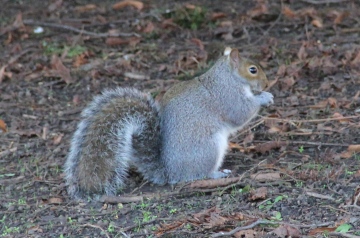 Also taking advantage of the warmth, in Highwoods was this beetle which I believe is Glischrochilus hortensis 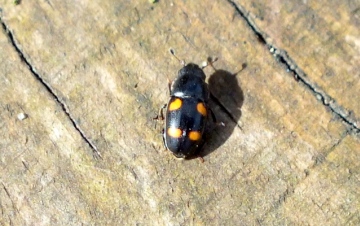 Found by my wife I hadn’t seen it before. In the ditches and on the roadside verges between Dedham and Ardleigh the white of Snowdrops has been replaced with the yellow of Lesser Celandine, all within a couple of days. The winter of 2011/12 was exceptional for Ladybirds, huge numbers overwintering in the area around Mistley Place Park and The Walls. This year there were very few. The wet summer last year seems to have taken a huge toll. Finally, if country sayings are to be believed, we noted one bad portent in Highwoods. Of the oak and ash growing there, ash buds are bursting while oak are still tightly shut. Not another summer like the last one. PLEASE. Sun 14th April 2013 18:09 by Graham Smith Pulmonaria
Jake,
This looks like Common Lungwort Pulmonaria officinalis. The basal leaves are generally heart shaped and stalked (you can't see them on this photo) and the stem leaves oval and half clasping the stem, like the ones shown. The white spotted leaves are characteristic (but may be shared by commercial hybrids as this is a popular plant in gardens) while the clusters of pink and blue flower-heads are typical of the family. This is a European species that is widely naturalised in Britain. Assuming this photo was not taken in a garden, the site and grid reference would be useful as it could then be added to the database for the Third Essex Flora - a work still in progress. Cheers Graham Smith |
Archives: May 2020Aug 2019 Jan 2019 Sep 2018 Jul 2016 Oct 2015 Jul 2015 May 2015 Apr 2015 Mar 2015 Feb 2015 Jan 2015 Dec 2014 Oct 2014 Sep 2014 Aug 2014 Jul 2014 May 2014 Apr 2014 Mar 2014 Feb 2014 Jan 2014 Dec 2013 Nov 2013 Sep 2013 Aug 2013 Jul 2013 Jun 2013 May 2013 Apr 2013 Mar 2013 Feb 2013 Jan 2013 Dec 2012 Nov 2012 Oct 2012 Sep 2012 Aug 2012 Jul 2012 Jun 2012 May 2012 Apr 2012 Mar 2012 Feb 2012 Jan 2012 Dec 2011 Nov 2011 Oct 2011 Sep 2011 Aug 2011 Jul 2011 Jun 2011 May 2011 Apr 2011 Mar 2011 Feb 2011 Jan 2011 Dec 2010 Nov 2010 Oct 2010 Sep 2010 Aug 2010 Jul 2010 Jun 2010 May 2010 Apr 2010 Mar 2010 Feb 2010 Nov 2009 Oct 2009 Aug 2009 Jul 2009 Jun 2009 May 2009 Apr 2009 Mar 2009 Feb 2009 Jan 2009 Nov 2008 Oct 2008 Sep 2008 Aug 2008 Jul 2008 Jun 2008 May 2008 Apr 2008 Mar 2008 Feb 2008 Jan 2008 Dec 2007 Nov 2007 current posts |



















